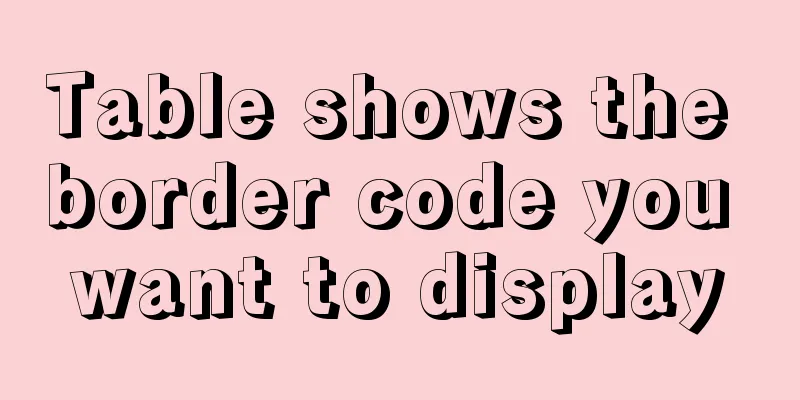Example of using HTML+CSS to implement a secondary menu bar when the mouse is moved

|
This article introduces an example of using HTML+CSS to implement a secondary menu bar when the mouse is moved. The details are as follows: First, the effect picture: 1. The mouse is not on it
2. Place the mouse on the first-level menu to expand the second-level menu
3. Place the mouse on the secondary menu
Code:
<html>
<head>
<title>Secondary menu test</title>
<meta charset="utf-8">
<style type="text/css">
/*To center the menu*/
body {
padding-top:100px;
text-align:center;
}
/* -------------Menu css code----------begin---------- */
.menuDiv {
border: 2px solid #aac;
overflow: hidden;
display:inline-block;
}
/* Remove the underline of the a tag*/
.menuDiv a {
text-decoration: none;
}
/* Set the style of ul and li */
.menuDiv ul , .menuDiv li {
list-style: none;
margin: 0;
padding: 0;
float: left;
}
/* Set the secondary menu to absolute positioning and hide it*/
.menuDiv > ul > li > ul {
position: absolute;
display: none;
}
/* Set the style of the li of the secondary menu */
.menuDiv > ul > li > ul > li {
float: none;
}
/* Put the mouse on the first-level menu to display the second-level menu*/
.menuDiv > ul > li:hover ul {
display: block;
}
/* First level menu */
.menuDiv > ul > li > a {
width: 120px;
line-height: 40px;
color: black;
background-color: #cfe;
text-align: center;
border-left: 1px solid #bbf;
display: block;
}
/* In the first level menu, do not set the left border */
.menuDiv > ul > li:first-child > a {
border-left: none;
}
/* In the first level menu, the style of the mouse on it*/
.menuDiv > ul > li > a:hover {
color: #f0f;
background-color: #bcf;
}
/* Secondary menu */
.menuDiv > ul > li > ul > li > a {
width: 120px;
line-height: 36px;
color: #456;
background-color: #eff;
text-align: center;
border: 1px solid #ccc;
border-top: none;
display: block;
}
/* In the secondary menu, the first one sets the top border*/
.menuDiv > ul > li > ul > li:first-child > a {
border-top: 1px solid #ccc;
}
/* In the secondary menu, the style of the mouse on it*/
.menuDiv > ul > li > ul > li > a:hover {
color: #a4f;
background-color: #cdf;
}
/* -------------Menu css code----------end---------- */
</style>
</head>
<body>
<!-- -------Menu html code---------begin------- -->
<div class="menuDiv">
<ul>
<li>
<a href="#">Menu 1</a>
<ul>
<li><a href="#">Secondary Menu</a></li>
<li><a href="#">Secondary Menu</a></li>
<li><a href="#">Secondary Menu</a></li>
</ul>
</li>
<li>
<a href="#">Menu 2</a>
<ul>
<li><a href="#">Secondary Menu</a></li>
<li><a href="#">Secondary Menu</a></li>
</ul>
</li>
<li>
<a href="#">Menu Three</a>
<ul>
<li><a href="#">Secondary Menu</a></li>
<li><a href="#">Secondary Menu</a></li>
<li><a href="#">Secondary Menu</a></li>
<li><a href="#">Secondary Menu</a></li>
<li><a href="#">Secondary Menu</a></li>
</ul>
</li>
<li>
<a href="#">Menu 4</a>
</li>
<li>
<a href="#">Menu Five</a>
<ul>
<li><a href="#">Secondary Menu</a></li>
<li><a href="#">Secondary Menu</a></li>
<li><a href="#">Secondary Menu</a></li>
</ul>
</li>
</ul>
</div>
<!-- -------Menu html code---------end------- -->
</body>
</html>
The above is the full content of this article. I hope it will be helpful for everyone’s study. I also hope that everyone will support 123WORDPRESS.COM. |
<<: How to use nginx as a proxy cache
>>: CSS imitates Apple's smooth switch button effect
Recommend
Content-type description, that is, the type of HTTP request header
To learn content-type, you must first know what i...
How to implement Mysql switching data storage directory
How to implement Mysql switching data storage dir...
Detailed explanation of the use of Vue h function
Table of contents 1. Understanding 2. Use 1. h() ...
CSS Skills Collection - Classics among Classics
Remove the dotted box on the link Copy code The co...
Detailed explanation of JavaScript function this pointing problem
Table of contents 1. The direction of this in the...
How to move mysql5.7.19 data storage location in Centos7
Scenario: As the amount of data increases, the di...
Summary of 7 pitfalls when using react
Table of contents 1. Component bloat 2. Change th...
Usage of HTML H title tag
The usage of H tags, especially h1, has always bee...
Use of Vue filters and custom instructions
Table of contents Filters 01.What is 02. How to d...
Detailed tutorial on installing MySQL 8.0 from source code on CentOS 7.4
Table of contents 1. Environment 2. Preparation 3...
Tutorial on installing GreasyFork js script on mobile phone
Table of contents Preface 1. Iceraven Browser (Fi...
How to install Nginx in CentOS
Official documentation: https://nginx.org/en/linu...
Vue custom table column implementation process record
Table of contents Preface Rendering setTable comp...
Detailed explanation of the watch listener example in vue3.0
Table of contents Preface The difference between ...
Vue two same-level components to achieve value transfer
Vue components are connected, so it is inevitable...












